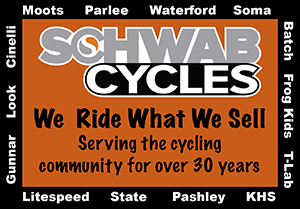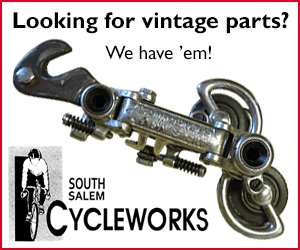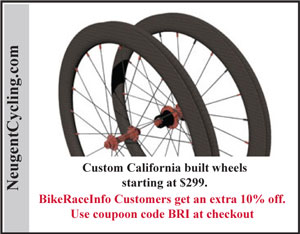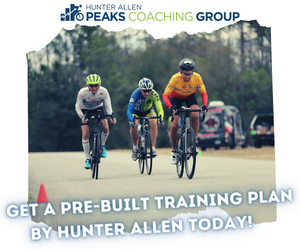

Greg LeMond
An Interview with Professional Cycling's Talented Revolutionary
By Chairman Bill McGann

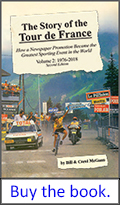
Bill and Carol McGann's book The Story of the Tour de France, Vol 2: 1976 - 2018 (which covers LeMond's Tour years) is available as an audiobook here. For the print and Kindle eBook versions, just click on the Amazon link on the right.
Our story:
I have long believed that Gregory James LeMond is the most physically talented rider since Fausto Coppi. The easy mastery he displayed from his first racing days made his natural ability clear. He could do more than just kick out watts in staggering quantities (big numbers for his time, but more about this in the interview), he was one of his generation's finest bike handlers. In short, he was a complete rider, one of the finest in cycling history.
Interviewing this winner of three Tours de France was a pleasure. Greg is affable and avuncular. He never avoids giving a straight, blunt answer to a question. Being very intelligent and passionate about cycling, he remembers almost every pedal stroke of his career.
I can understand how some people, reading some of the interviews he has given in the last few years, might see a disagreeable personality. Nothing can be further from the truth. I think this is due to the limitations of the purely written word as well as a reluctance on the public's part to accept what he has had to say. His public utterances about the current state of cycling have caused more than a little cognitive dissonance in American cycling fans. Moreover, an interview often fails to convey the speaker's delivery and thoughtful charm. I think this is the case with Greg. I've never talked to anyone who has met Greg who was not left with the memory of having spent time with a person they genuinely liked and impressed by his intellectual grasp of all aspects of the sport.
LeMond was more than a superb rider. His approach to the sport was independent and analytical. He changed many aspects of pro cycling, from aerodynamics to pay. He retired years ago, but his time as a professional still powerfully affects the sport.
Here is a short list of LeMond's most notable accomplishments:
- 1977, 1979: 1st Junior National Road Championships
- 1979: 1st Junior World Road Championships
- 1981: 1st Coors Classic
- 1982: 1st Tour de l'Avenir, 2nd World Pro Road Championships
- 1983: 1st World Pro Road Championships, Dauphiné Libéré, 1st Super Prestige (roughly equivalent to modern Pro Tour)
- 1984: 3rd Tour de France
- 1985: 1st Coors Classic, 2nd Tour de France, 2nd World Pro Road Championships
- 1986: 1st Tour de France
- 1989: 1st Tour de France, 1st World Pro Road Championships
- 1990: 1st Tour de France
This is the first part of an extended discussion with Greg covering his entire cycling career. This installment covers his racing start to the end of his first year as a pro. We met in Valencia, California, February 24, 2007, during the Tour of California.
Chairman Bill: Before we begin exploring your cycling career, I would like the reader to understand the extraordinary physical talent you possessed. At the risk of asking you to brag, I believe you know what the numbers are that defined your ability to perform work: VO2 max, wattage, etc. What were they and how did they compare to the population in general and to the professional peloton when you were racing?
Greg LeMond: In the 80s when I was racing we did VO2 Max testing, but it was to see the physical fitness. My first VO2 Max test was up in Squaw Valley on a treadmill and I had a 79 VO2 Max non-specific sport. But once I actually really started doing VO2 Max testing on a consistent basis in '89... now you know it depends upon the level of fitness and training...I was on average about 6.2 to 6.4 liters of Oxygen, which translated to my racing weight would be 92, 93, 94 VO2 Max. I think only cross-country skier Bjørn Dæhlie [Generally considered the greatest Nordic skier of all time, 1992 Olympic Gold Medalist 15 km, 50 km, 4 x 10 km relay cross country skiing], had those same numbers. So I think I had one of, if not the highest.
Now I don't know Merckx's. I don't think Merckx ever did a VO2 Max. So, I'm certain he was up there. I think Bernard Hinault's VO2 Max was 88. I think I was of the top....
CB: 1 or 2...?
GL: 1 or 2, yes. At the top.
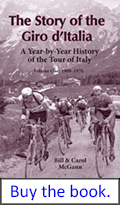
CB: Were you aware of what you could do in terms of average rate of vertical ascent? For instance, Ivan Basso made everyone's eyes bug out when he was ascending at 1800 vertical meters an hour on the Colle San Carlo in the 2006 Giro.
GL: What wattage was he doing? I would look more at wattage because the rate of vertical ascent could vary so much depending on the pavement. Wattage is the ultimate truth. You know I'm very controversial because I think that you have to look at numbers.
My wattage, relative to VO2 Max...a VO2 Max of 92 or 93 in a fully recovered way...I think I was capable of producing 450 to 460 watts. The truth is, even at the Tour de France, my Tour de France climb times up l'Alpe d'Huez yielded a wattage of around 380 and 390. That was the historic norm for Hinault and myself. You've got times going back many, many years. But what was learned recently, in the last 5 years, was that when you start the Tour de France, you start with a normal hematocrit of, say, 45 percent. By the time you finish, it's probably down 10 or 15 percent. Which means my VO2 Max dropped 10 or 15 percent. So that's why I was never producing the same wattage. And then there a lot of other factors that help performance if you've recovered. My last time trial in '89, I averaged about 420, 430 watts, which would match or be slightly down from what my real VO2 Max was.
Of course, in the '90s drugs came on the scene, so the wattages have gone out. There are some things that are just not explainable, people with VO2 Maxs in the low 80s producing 500 watts. A physiologist friend of my said that for a person to do that, 500 watts, he has to have to have nearly 100 milliliters of Oxygen. There are a lot of questions there for me.
When I start seeing wattage down to the historic norm, I'll know that the battle of the drugs is starting to get back in place.
CB: We can at least understand that statistically, the physical gift that you possessed was one in millions?
GL: I read in a deposition in a trial that an expert witness said that I couldn't have had a ninety [VO2 Max]...that I would have been a one in a thousand in the pro ranks to have that. I happened to have been in the 1980s and was probably the best rider out of a thousand pros. So [laughs], I was one in a thousand.
CB: Let's go on to your career. As a young teenager, you were a successful competitive skier?
GL: I didn't actually compete. I was into freestyle skiing. I went to a camp to learn how to do aerials. Then the following year I was hoping to do some competition. Mogul freestyle skiing was a new sport.
CB: You were 13?
GL: Yes, I was 13 and it was for my 14th birthday I was sent to up to Wayne Wong's ski camp. I was there specifically to get more knowledge about doing aerial flips and improve my mogul skiing. It was my birthday present for being 14 years old. The coaches there said that bike riding was the best sport to do to get in shape for skiing. I went back and bought a bike and ended up riding through the winter. I just happened to meet somebody in a bike shop, Rick's Bike Shop in Reno...
CB: Big Rick?
GL: Big Rick and a guy named Cliff Young who was in the shop, who was a racer in Northern California. He said, "You know, you should try racing. Come to our Reno Wheelmen club meeting."
Two weeks later I went there and they convinced me to do a club race, which I did. I showed up in tennis shoes, tank top and running shorts, 35-pound bike in the middle of the Reno winter. Everybody else had their leg warmers on, Italian bikes. I ended up getting second place out of it. It was a 28-mile race, 4 laps around a 7-mile loop right in front of my house.
They convinced my dad that I must have some special talent. So my dad got me a new bike, a Cinelli at Rick's Bike Shop. I got the shoes, the shorts. Two weeks later I started my first race in Sacramento and won my first 11 races.
CB: Were you an Intermediate then, 14 years old?
GL: Yes
CB: So, upon getting your USCF license you really won your first 11 races?
GL: Yes. And I was bored with winning the 11 races so I asked the officials to allow me to race in the junior category. This was a whole different age group, a much more competitive age group. There were hundreds of juniors in California. You'd go to a race like Nevada City and there'd be a hundred juniors.
CB: I remember that back then sometimes there would be so many juniors that they would break the field in half and run 2 junior races.
GL: Yes. There were more juniors then than there are today. Back then you'd have the 84 x 15 gear restriction for intermediates where the juniors were 52 x 15. So I was second in Nevada City. Most of the races I entered I was second or third because I didn't have the gear to sprint.
CB: For a second year racer, your 1977 could only be described as stunning. Let me recite the statistics. You won over half the races you entered, (27 out of 47) and became the Junior National Champion and won the Junior World's trials. Can you describe what your life was like at this point?
GL: This was the first year I really raced outside of Northern California. I went to the Nationals the year before but I think one of my best memories was going to the Junior World's Trials. I was just 15 at the time, going on 16. I ended up winning 2 out of the 3 races. I was first, second, first. Obviously I was the strongest rider there, but they wouldn't let me go to the World's because I was a year too young. I think they could have made an exception and I could have gone, but they didn't do it.
CB: Any particular races besides the trials stand out in that year?
GL: Obviously wining my first National Championship in Seattle was exciting. It was on a very hilly course and I crashed 3 times. I kept crashing and coming back. At that time I was so driven that crashes didn't even faze me. I got back up to the lead group, they had a couple of minutes on me. I bridged back up to them and then won the sprint against a rider who ended up being one of my better friends, Jeff Bradley. I won that year and the next year he won and then the following year I won the national championships and he was second. So we were first-second, first-second.
CB: You and you father were traveling and racing together?
GL: We were kind of like a family unit then with a Volkswagen Vanagon. Most every weekend we went from Reno to the [San Francisco] Bay area.
CB: There was lots of racing in the Bay area then.
GL: Every weekend I could race, starting from February. We'd come down to Southern California occasionally to race. By the time I was in my third year in '78, I was winning most of my junior races, so I was given permission to ride in the senior category. I raced against John Howard in the Tour of Fresno. He couldn't drop me. Again, I was riding with restricted gears.
We were riding a time trial and I was up by 20 seconds up at the turnaround into a headwind and I lost by 10 seconds because the tailwind was so strong that I couldn't pedal fast enough with my junior gears. I was spun out.
CB: And Howie used big gears...
GL: Yeah yeah, a 56...That was really a standout for me because that confirmed that I could compete against the best in America, even 10 years older. In '78 I had my first World Championship in Washington DC where I got a bronze medal in the team time trial, a ninth place in the road race. That's where I broke my saddle, which happened right in the beginning, I broke a titanium saddle. So I sat on a broken saddle the whole race.
And then one of my best friends, Kent Gordis (who wrote my book in '85) invited me to stay at his dad's house in Switzerland. We spent 2 months in Switzerland. Basically, the family; Kent, his mom and I, drove around Switzerland, France and Belgium and raced all the top junior races. I won the 2 races I entered in Switzerland, a big, big criterium in Embrach, near Zurich. It had all the top juniors racers in Switzerland there. Then a race in Sion-Sierre, near Crans Montana, near Italy. Won that race.
Went to France, won 2 other races and went to Belgium and won 4 or 5 other races. Then I flew to Poland and won 1 race and then got third overall in this big Czechoslovakian-Polish Eastern Block race. So that was my period when I realized that I could be as good as the Europeans. And that was at 17.
CB: You were racing what would turn out to be the first successful American demographic cohort to race and win internationally, both as amateurs and professionals. Did you and the others (Bradley, Demgen, Kiefel, etc) sense that you were bringing American racing to a substantially higher level?
GL: I think that there was a sense that Eddy B, Eddy Borysewicz, the coach, was able to get our team in the team time trial together. But I don't think those riders really looked at going to Europe and doing well. I think I was on another level, above my competitors.
CB: You had greater ambitions than they had?
GL: I think they knew that I was significantly stronger than they were. At that time nobody thought we could compete in Europe. None of those riders had ambitions of going to Europe. I think it was only once I got there and started racing and they got more mature and started racing on the national team in Europe, they started doing better in the international races.
By '84 and '85 they put together the 7-11 team and then they raced internationally. It's kind of like they waited to let me test the waters and then they would come over.
CB: In addition to your family, were you getting help and guidance from others besides Eddy B, like Roland Della Santa?
GL: In the beginning yes. Roland sponsored me in my second year of racing with bikes. As a junior I got a lot of prize money racing. By the time I was 16 was I basically paying all of my own expenses, from race winning and sponsorships. At 17, I got Grab-On as a sponsor and possibly Palo Alto Bike Shop. Avocet sponsored me in 1980. I was just 18, but I made about $30,000 that year.
CB: These are 1980 Dollars!
GL: Yes, which is quite a bit on money for an 18-year old. I bought my first car with my race winnings.
CB: 1978. You were only winning a third of the races you entered. Were you traveling to bigger and harder races?
GL: A third? I think I was winning more than that. Well, that might be right because I was in the senior category. That might be right. In 78 I went to Europe for 2 months and raced and won most of the races I rode over there.
CB: You and the rest of the junior team put yourselves on the map with a third in the team time trial and your ninth in the road race, which you talked about. How do you explain the improvement in American placings in international competition? Do you think it as just having a larger pool of riders from which to draw, because the junior pool was so huge?
GL: I think so. That was a major factor. I think the biggest reason for improvement was the Olympic Training Center and Eddy B. He defected from the Olympics and put some structure [on the program]. He didn't focus on the seniors. He focused on the juniors. He really put all of his efforts on the team time trial and teaching riders about intervals, how to train and about quality over quantity. He was a believer in very hard intervals in February, which, at the time, you just did long, slow miles.
CB: It was the long, slow distance era...
GL: Yes. And his training is relevant today. He was the one who put the structure into the training and motivated the riders and motivated the National Federation to send teams to Europe to race. So, it started in '78, '79, '80. 1980 was when I went to Europe with the National Team where I won Circuit de la Sarthe, which led to my getting an offer to race professionally. When I look at the numbers of junior riders today compared to when I was racing there's probably a third less racing today than in the 70s.
CB: Smaller pool?
GL: Smaller pool. So the secret for the future of cycling is to figure out how to draw a bigger pool from all of these American athletes. That's the challenge. That's a big challenge.
CB: Had you yet decided to embark on a career as a cycling professional?
GL: In 78? That was my dream!
CB: It wasn't a concrete fact in your mind at that point?
GL: No, no. It was a concrete fact! By '76, my first year, by '77 when I started learning about the Tour de France. In '78 I spent 2 months in Europe. I was staying in Geneva. I rode my bike with Jean-Claude Killy. I was racing with the Geneva team when I rode races in Switzerland. We did a ride from Geneva to the Joux-Plane, which is a big mountain before Morzine. We were able to watch from Jean-Claude Killy's chalet the Tour de France go over the mountain. When I saw that... that's what I wanted to do. What was interesting was that for me, it wasn't just a dream. I was winning most of my races in my first year, pretty much the dominant racer in my category the second year. My third year I was racing with John Howard, and all the top amateur racers and was just as competitive as they were.
And when I went to Europe, the 2 races in Switzerland, I rode, I won. The 2 races in France I won. They were all big races at that time.
CB: You won every race you rode in Belgium?
GL: No, I had 2 seconds. I won 3 races and got 2 seconds and then I went to Poland and won one stage and got third overall. I came back from that trip with the idea that...well the mentality of Americans at that time was that the European were so much better and that they were such bigger talents. But for a 17-year old kid, at the time, I think it was pretty logical to think that Eddy Merckx had to start somewhere. I'm just as good as any Belgian or and French or Swiss rider so why can't I take them on in the Tour?
I made a list of goals in 1978. 4 Goals:
- Junior World Championship
- Olympics
- World Championships at 22
- And Tour de France at 25.
Nobody was going to stop me. This is what I was going to do. The quicker I could do it and get to Europe the better.
[CB: We talked a bit about his advocacy at the time of the importance of other riders going to Europe to improve and how many thought it best to stay in the U.S....]
GL: That was the mentality of the American racers. That was right when the Red Zinger was starting. There was the thought that we should keep our talent in America. If your goal was to win the National Championship or the Red Zinger, that was fine. My goal was to win the Tour de France.
CB: That was the era when the goal was to make the Olympic team, not to win the Olympics.
GL: The Americans would peak for the Trials with the thought that once they got to the Olympics, "Let's just finish the race."
In the 79 Junior World Championships I got 3 medals, one on the track in the pursuit and the team time trial. We probably would have done better in the team time trial had we not lost a rider from a crash. But then I ended up winning the Junior World Championships 2 days later.
CB: Were you America's first Men's World Road champion? [Audrey McElmury won the Women's Road Championship in 1969 and Frank Kramer was World Sprint Champion in 1912]
GL: Yes.
CB: In 79, what team were you riding for?
GL: In 79...I was racing on a Raleigh, I think it was Avocet. In 1979 as a junior I made about $20,000 in prizes and sponsorships, which were used for travel and expenses. In 1980 I made about $30,000. I'm only saying this because when I turned pro, I turned pro for an astronomical, highest neo-pro paid ever at $12,000 for the year. I took a pay cut, to a third.
CB: Beats the heck out of poor Brian Robinson, who in the 1950s got a jersey and a bike!
GL: Oh God, yeah. At least I got all my expenses paid.
CB: OK, at the end of 79 you are both the National and World Junior Champion, with a second in the Junior Word's pursuit race thrown in for good measure. You are about to become a senior men's racer. What is your plan for the next year?
GL: My goal was the Olympics. 1980 was the Olympics. It was in Moscow and so my goal was to win the Olympics, my next goal. I won my first goal, which was the Junior World Championship. My second goal was to win the Olympics.
I went over in April with the National Team and competed in three 5-day stage races. One, Circuit des Ardennes, which I won a stage and got third place overall.
CB: You won the Circuit de la Sarthe.
GL: The Circuit de la Sarthe was really my big breakthrough because it was against professionals, East Germans, Eastern block countries.
And when I won it, that sparked the interest of Cyrille Guimard, who then came to the next race I was riding, the Ruban Granitier de Breton, which is another 5-day race. I was in a breakaway with 5 Russians and a Belgian. Had I just stayed with that group I would have won that race. I got a flat tire in the last day and my follow car wasn't behind me. I ended up losing about 2 and a half minutes to the break, which I would never catch because they were 5 Russians riding flat out. And the peloton was 2 and a half minutes behind, which meant that I just lost the whole race. I was... emotionally pissed off.
Lejeune bikes were sponsoring the U.S. team and helping with part of the expenses.
CB: Was this all as part of the National Team?
GL: Yeah, We had no money. We were shoestringing it over there. The organizers paid for the hotels. Lejeune help cover some of the mechanical stuff. So, when I had a flat, I waited and waited and waited. The Belgian team came up and handed me a wheel. Then the Lejeune car came up..."Where the heck have you been..?", I told the mechanic, "I'm done. You just cost me the race."
The mechanic insisted that I finish the race for the sponsor as if I had some moral or financial obligation to the sponsor. When he said that I got off and threw his Lejeune bike at the car and said, "I'm done."
Cyrille Guimard saw that. He came to me after the stage and said in interviews later that, "When I saw his temperment, that is when I decided that's who I wanted on the team."
CB: That Fall Bernard Hinault and Cyrille Guimard traveled to Nevada to talk to you?
GL: Yep. I signed my contract. What happened was that after I won the Circuit de la Sarthe and Guimard approached me and I was approached by Peugeot and another French team, I forgot which French team. I actually started negotiating between the 2 of them
CB: You were playing them against each other?
GL: I was playing Peugeot and Guimard off. Peugeot was willing to pay me 15,000 Francs a month versus 6,000. I was trying to get Renault [Guimard's team] up but I already knew that Renault was the one I was going to go with.
CB: Was that because of Guimard?
GL: Yeah. He was the best coach, way better than on any other team out there. I just knew that Guimard the coach and I think he turned out to be the best coach of all time, really.
CB: I am told that when he does racing commentary on TV it is the most insightful.
GL: He is a great tactician. He wasn't the best cyclist, but he won races. The best director sportifs aren't usually the true champions. There are the ones who have to scrape by.
CB: It's the same with baseball managers.
GL: Yes. You have to tactically figure it out. But he was more of a great psychologist. He was able to look at each rider independently, get to know him. And that's why he came to Reno with Hinault. It was to see how I lived, meet my parents, know my background, so that he would understand me.
For my first 3 years he let me come home in the middle of the season for 3 or 4 weeks, knowing that I would be homesick. And I was. It was a great relief. The thought of spending January to October in Europe was just a nightmare for me. I like Europe a little bit but I like home a lot more.
CB: What did they pay you your first year?
GL: I don't remember what the exchange rate was. It started off at $18,000 a year [in French Francs]. The Franc weakened and the Dollar strengthened and it dropped down to $12,000. But Guimard, halfway through the season, after I was third in the Dauphine that year, won my first race, the Tour de l'Oise (the main thing was being third behind Hinault in the Dauphine, which was THE race for preparing for the Tour), he gave me a raise. He knew about the Dollar fluctuation and upped me to $25,000 a year. It was generous. He tried to make my life...he treated me very well.
CB: After they signed you, what did they say their plans were for you for the coming 1981 season?
GL: I was 19. So Guimard said, "Your first year, we want you to do ''t going to race a full, hard program. What we want you to gain this year is experience. We'll pick out a few races, the Dauphine, the Coors Classic as races to focus on."
CB: He wanted to invest in you?
GL: Yes. He thought I was going to be the next Hinault. He told me that. He told me, "You're the biggest talent I've ever seen." He told me I was a bigger talent than when he met Hinault. He said we'll race the Tour de France when you're ready and between you and me we'll win a lot of races.
CB: Hinault didn't show instant natural ease of winning races that you had.
GL: Be he was great though...
CB: But his progress was more developmental.
How did you prepare over the winter of 80-81? You signed your contract and then...
GL: I signed my contract on the last day of the Tour de France on the Champs Elysées, the day the race finished. I was getting married. I was engaged to my wife and we begged her parents to let us get married before I moved away to Europe. We couldn't imagine living away from each other. She was going to college. So we decided to get married in December 21st of that year, just before I went to Europe.
I had a [pair of] Belgian friends, Noël Dejonckheere, who was a professional racer and his brother Richard. Ill-advised, my friends told to me to take 6 months off and just have fun because once you turn pro you'll never take 6 months off again until you're done. Most racers will race 15 years. So I literally did that. I got so out of shape, deconditioned and gained about 10 pounds.
So I started riding right after our wedding. We went to San Diego to start training. I showed up at the early season just out of shape and pudgy. Guimard had me do a race that was 110 miles and then do another 40 miles afterwards. I went from about 150 to 135 in about 6 weeks. I was skinny, skinny, skinny after about 6 weeks.
CB: When did you go over to Europe to live? Where did you go to live?
GL: I negotiated a contract that had a salary, airline tickets, a car and a house. Guimard wanted me close to him. He lived near Nantes. So he got me a house in a town called La Chapelle-sur-Erdre. He promised that it would be furnished. When we showed up in January 9th... no furniture. So we spent 2 weeks in a hotel and then my wife moved in with a mattress and a cooking pan. I went off for 4 weeks to a training camp and left my wife there all by herself. Fortunately my mom came over for a week or 2 and spent some time with her. But the furniture...they kept saying next week, next week. It was the middle of April when we finally got furniture. It was not a pleasant experience.
CB: You got a quick dose of the French and Italian sense of urgency? The Italians have a word, "Subito" which is literally translated as "right now", but really means soon, if it is convenient.
GL: [laughs] Exactly.
CB: What was your first pro race?
GL: I think it might have been the Étoile de Bessèges.
CB: Very early, in February, in the South of France?
GL: Got dropped.
CB: You were riding a Campagnolo-equipped Gitane? Do you know who built your bike?
GL: Gitane. It was from the factory, but it was custom-made.
CB: We've talked to lots of pros who found that first year as a pro with the longer races and higher sustained speeds was quite a shock and took some adjusting. How about you?
GL: Had I trained like I normally did and not taken my Belgian friend's advice and kept myself in shape, it would not have been a bad transition. It took me through February and that training camp to really drop about 10 pounds. By March I starting to feel good. April I felt actually quite good in Paris-Roubaix. I was really helping Hinault. He won his first Paris-Roubaix and only Paris-Roubaix that year.
CB: And he hated it...
GL: Yeah....I loved it. I did a big final attack that split the race up for Hinault and then I just bagged it after 230 kilometers.
CB: So you were in pretty good shape by April?
GL: By April I was. And then I went back to the U.S. for a break. I came back and did my first race, the Tour de l'Oise. I won a stage in it in front of Phil Anderson. That was my first pro victory. And then 10 days later I started the Dauphiné Libéré. I ended up getting 4th place but the 3rd place rider was caught doping so I moved up to 3rd place.
And then just shortly after that we flew back with the Renault team to the Coors Classic which had the Russian Olympic Gold Medalist.
CB: Soukouroutchenkov?
GL: Soukouroutchenkov and Barinov [1980 Olympic bronze medallist] and the whole Russian team, which for me was, for me, a test to see who would have been the Olympic champion. This was my real revenge on missing the Olympics. I can't believe we actually boycotted the Olympics because they invaded Afghanstan. We've invaded 2 countries and nobody has boycotted anything right now.
That race I ended up winning, I don't know how much time I took out of Soukouroutchenkov, something like 10 minutes. We went head to head. Me against 4 Russians on the Morgul Bismark course. They tried every which way to drop me and every time they would attack I'd chase one guy down. I would slow down just before I caught him. And then as the other group caught up, just before they caught up I'd do an attack and drop everybody. Then I'd slow down and then when they would catch me they'd send somebody off and the immediately I'd go after him.
I just played this game with them and they couldn't drop me and I ended up second in that stage. I won that race. That was my big victory for '81, the Coors Classic.
After that I stayed in the United States until August, came back and did some criteriums with Hinault, who won the Tour de France that year. I raced the World's and that was my last race and came home after that.



